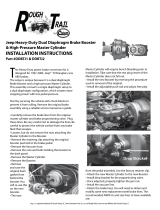
Wilwood • Phone 805 / 388-1188 • Fax 805 / 388-4938 • www.wilwood.com
• Make sure pedal is firm: Hold firm pressure on pedal for several minutes, it should remain in position without
sinking. If pedal sinks toward floor, check system for fluid leaks. DO NOT drive vehicle if pedal does not stay firm
or can be pushed to the floor with normal pressure.
• At very low speed (2-5 mph) apply brakes hard several times while turning steering from full left to full right, repeat
several times. Remove the wheels and check that components are not touching, rubbing, or leaking.
• Carefully examine all brake components, brake lines, and fittings for leaks and interference.
• Make sure there is no interference with wheels or suspension components.
• Drive vehicle at low speed (15-20 mph) making moderate and hard stops. Brakes should feel normal and
positive. Again check for leaks and interference.
• Always test vehicle in a safe place where there is no danger to (or from) other people or vehicles.
• Always wear seat belts and make use of all safety equipment.
WARNING • DO NOT DRIVE ON UNTESTED BRAKES
BRAKES MUST BE TESTED AFTER INSTALLATION OR MAINTENANCE
MINIMUM TEST PROCEDURE
Bleed The Brake System
•Fill and bleed the new system with
Wilwood Hi-Temp° 570
grade fluid, or for severe braking or sustained high heat
operation, use Wilwood EXP 600 Plus Racing Brake Fluid.
Used fluid must be completely flushed from the system to
prevent contamination (even if re-bleeding your existing
system). NOTE: Silicone DOT 5 brake fluid is NOT
recommended for racing or performance driving,and
remember to never mix different grade brake fluids.
•To properly bleed the brake system, begin with the caliper
farthest from the master cylinder. Bleed the outboard bleed
screw first, then the inboard. Repeat the procedure until all
calipers in the system are bled, ending with the caliper
closest to the master cylinder. NOTE: When using a new
master cylinder, it is important to bench bleed the master
cylinder first. Please refer to Wilwood’s data sheet DS-487
available at www.wilwood.com/PDF/DataSheets/ds487.pdf.
Or access this URL below to watch the video
http://www.wilwood.com/video/VideoDisplay.aspx?id=22.
•Test the brake pedal. It should be firm, not spongy and stop
at least 1 inch from the floor under heavy load.
If the brake pedal is spongy, bleed the system again.
If the brake pedal is initially firm, but then sinks to the floor, check the system for fluid leaks. Correct the leaks (if applicable)
and then bleed the system again.
If the brake pedal goes to the floor and continued bleeding of the system does not correct the problem, a master cylinder with
increased capacity (larger bore diameter) may be required. Wilwood offers various lightweight master cylinders with large
fluid displacement capacities.
•If after following the instructions, you still have difficulty in assembling or bleeding your Wilwood disc brake components, consult your
local chassis
builder, or retailer where the item was purchased for further assistance. Additional information is also available on
Photo 1. Proportioning Valve Bracket Kit Final Installation
(left hand shown)









